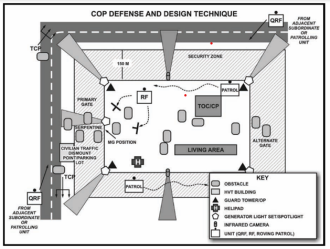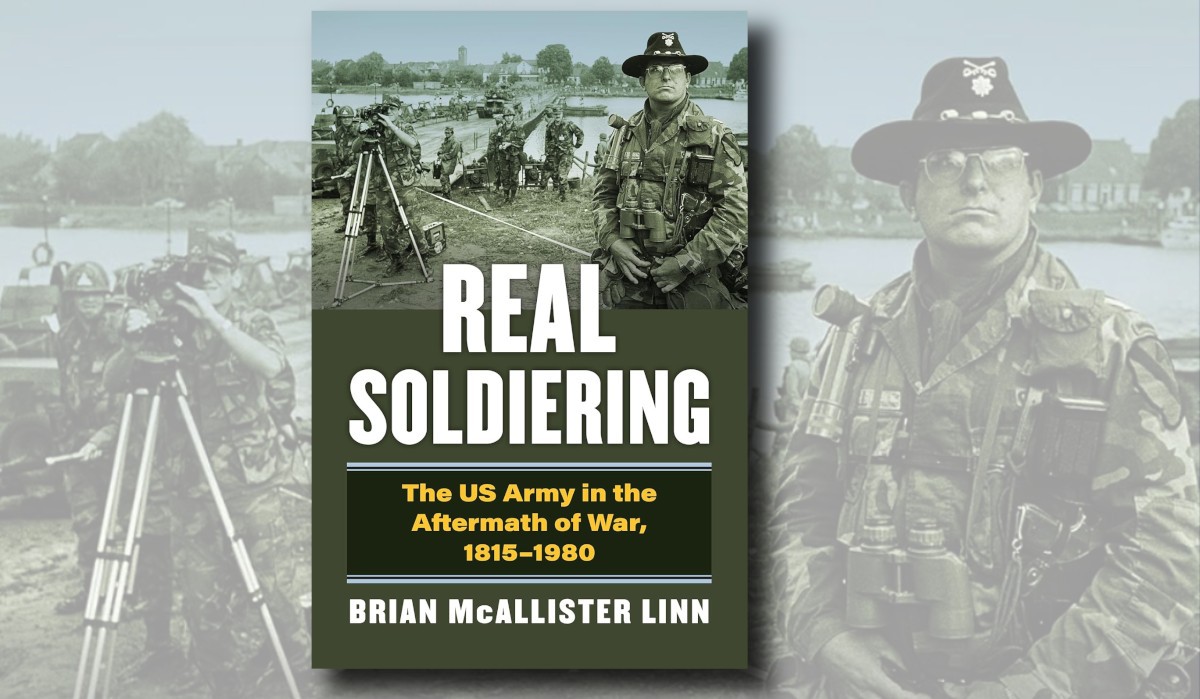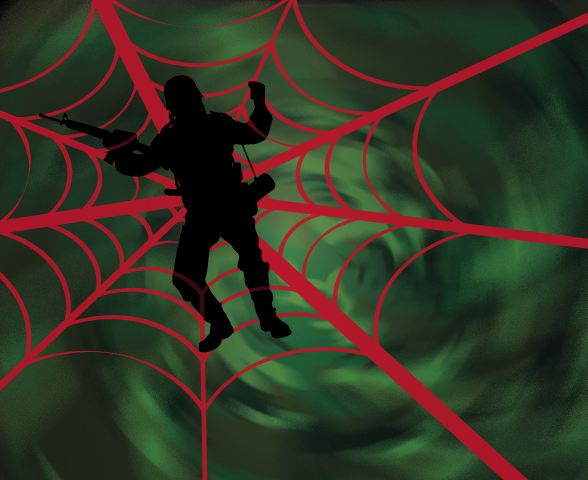The Question of Urban Position Minimum Strength
Context
Deploying a perimeter of detection, backed up by an appropriate response capability, is a key personnel-intensive requirement for gaining and retaining a secure Air or Sea Point of Entry (POE). As such, it is a critical Army enabling function for the Integrated Force to execute ‘anti-access/area denial’ (A2/AD) in the littoral as directed by the Defence Strategic Review (DSR). Furthermore, almost invariably the POE will be urban, which means that any perimeter will require a significant number of Observation Posts (OP). As explained in Part 3 of this LPF Littoral Series, the indicative number is at least 20 to 30. Therefore, the minimum total force required will be a function of the number of OP and the minimum number of soldiers that must occupy them. This post explores the question of what should be this minimum strength.
Threat Discussion
In the Asia Pacific region the number of heavy load capable POE is limited. As such, they are a logical and potentially high payoff target for both adversary preparatory intelligence operations during competition and the focus of preparation and planning for attacks during conflict. Importantly, the denial strategy outlined in the DSR envisages A2/AD deployments at significant distance from main threat force’s conventional forward adversary. This threat may be considered at three stages:
- Prior to conflict. Before hostilities, an adversary will seek to disrupt allied cooperation by emphasising political, legal and propaganda warfare against and in potential host nations. To retain deniability, any kinetic attack is likely to be executed covertly – perhaps by a proxy violent-political or crime group. Such groups might conduct close kinetic attacks on poorly protected targets, or harass from overwatch positions. They would be unlikely to attack and then remain to fight.
- Early in a conflict. Once hostilities begin, an adversary might deploy previously infiltrated agents or special forces (SF) or may activate teams of proxy actors. Operations against such threats are hard to execute with more than very small teams, unless there is a sympathetic (or coercible) community or local violent political conflict to exploit. Nevertheless, such operations are part of adversary doctrine, and new technologies substantially increase their potential. Weapons such as high velocity precision grenade launchers and anti-matériel rifles can destroy static aircraft, ships systems and unloading logistic platforms at a range of about a kilometre. There are other potent portable weapons systems that might be cached prior to conflict. Examples include anti-tank guided weapons with thermobaric warheads, guided 107mm rockets, anti-helicopter mines and surface-to-air missile systems, all of which can be pre-emplaced or employed at a stand-off of over 2km.
- A developing conflict. As regional conflict continues, the adversary may have the opportunity to deploy tactical strike systems within range of the POE, while SF or civilian agents provide the assured level of target data that is preferred for strategic strike. The adversary might also act as enablers for an enemy urban disruption-seizure operation, where a raiding force is infiltrated to seize undefended dominant structures, the possession of which can disrupt or prevent use of the POE.
Broadly speaking, in a situation in which deployment is at the invitation of the host government the likely threat is from small groups using stand-off weapon systems. However, in several of the countries where deployment is plausible, there are significant insurgent groups, which must also be considered.
Population Attitude
The attitude (or political alignment) of the people within a host nation is arguably the most significant factor for POE operations planning. On the one hand, the population may represent a hostile sea in which an adversary can swim unseen and protected and where friendly forces must be postured to defend themselves. Alternatively, it may constitute a well-attuned human sensor network, amongst which friendly troops can be hidden and be warned of threats. Positive relationships between the Australian Defence Force (ADF) and a range of host nation communities – as well as their security and military forces – is of the highest importance operationally as well as politically.
from FM 3.24.2 (Counterinsurgency)
indicative of a platoon plus task (source: author).
Population attitude has significant implications for the total numbers required for an urban POE operation. Specifically, it can determine the smallest size of force element that could be independently deployed depending on the need for different levels of self-defence. For illustrative purposes, consider the lessons from 20 years of counterinsurgency (COIN) experience on the determination of force numbers required to maintain self-protective security amongst a hostile population. Based on US experience portrays a suggested doctrinal arrangement of a COIN combat OP. It shows four guard towers and gate sentries, which suggests that at least a small section must be on duty at any time. While this analysis does not suggest the establishment of such well-developed positions, there is strong evidence that at least a small platoon would be required to occupy and maintain 24-hour OP. However, where the population is not hostile, or even supportive, positions can be smaller, better concealed, and more focused on observation.
Based on historical experience, Table 1 below indicates the minimum necessary size of an individual force element if it is operating separately from other elements and conducting a security task facing different threats and population attitudes. Actual numbers will depend on a range of factors, but this ‘model’ still gives a useful indication of variability. The Table is arranged to show that the domestic population may have a supportive, neutral or hostile attitude as indicated on the vertical axis. The horizontal axis shows that the threat forces may be small groups of infiltrators (trying to penetrate a perimeter), insurgents (with the strength to attack in groups of 20 to 30 and force a breach in the perimeter) or come from conventional forces (operating in company or greater strength at the point of attack to capture and hold ground).
The guidance provided by the Table can be applied to a typical infantry-centric battalion battle group (BG) tasked to deploy as many security posts as possible. With a small group infiltration threat and a supportive domestic population, all of the BG’s 27 (nominal) infantry sections might be independently deployed in sections of 8 to 10 soldiers. However, if the population is hostile, individual combat OPs might need up to 30 soldiers to avoid being overwhelmed by hostile mobs (and noting the likely constraints on using lethal force in self-defence). A neutral domestic population lies in between. Similarly, if there is a significant guerilla-type proxy force able to concentrate perhaps 30 fighters, while at the same time a supportive domestic population, it will be far harder for that enemy to mount an attack. In this situation, OPs of approximately 20 soldiers may be sufficient. By contrast, with a hostile domestic population aligned with an insurgency–level threat, decades of COIN experience suggests that company bases with up to 90 soldiers may sometimes be required. Again, a neutral population probably lies between these.
For completeness the Table also considers the less likely case where there is a conventional ‘raiding’ threat of enemy company combat team (CT) size. The Table highlights that, defending POE conventionally requires substantial forces and this assessment aligns with historical experience. It should be noted that defending against a conventional threat does not typically require larger individual positions (indeed dispersal may be required), however forces must typically be arranged to provide mutual support to each other. This requirement significantly decreases the urban terrain that a given size force can cover.
| Infiltrating small groups of SF or agents | Significant Proxy Force/ Guerilla threat | Conventional threat in Company strength at point of attack | |
|---|---|---|---|
| Hostile domestic population | Pln combat outpost (Bn = ~9 locations) | Coy base (Bn = ~3-4 locations) |
Fortified multiple Pln minus posts within mutually supporting Coy defended positions (Bn = 3-4 adjacent locations) |
| Neutral domestic population | 2 Sect combat outpost (Bn = ~13 locations) | Pln combat outpost (Bn = ~9 locations) | Mutually supporting fortified Pln posts (Bn = 10 adjacent locations) |
| Supportive domestic population | Distributed Sect posts (Bn = ~27 locations) | 2 Sect combat outpost (Bn = ~13 locations) | Mutually supporting fortified half Pln posts (Bn = 16 adjacent locations) |
Table 1. Indicative historical force levels for individual positions on urban terrain facing different levels of threat and showing the significance of population attitude (source: author)
Conclusion
Part 3 of this LPF Littoral Series demonstrated that, for an urban POE secured by a conventional infantry force, the minimum necessary number of OP will probably be between 20 and 30. Building on this analysis, this post has further shown that the numbers required in each OP might vary considerably, with questions of local political violence and the attitudes of the host population being crucial. The latter factor highlights the central importance of building positive relationships between deployed elements and host populations. As such it reinforces the criticality of international engagement to shape positive relationships in host countries prior to the conduct of military operations. It further follows that, it is important for a small army to enhance its capability so that smaller elements can operate independently and/or be more effective in maintaining security in order to reduce the personnel bill and operational risk. Such enhancements (which might come from beyond Army) will also improve ADF capability for urban operations more generally and are the subject of the next article in the series.
Complete Series:
Part Two: Army’s Role in the Strategy of Denial: Point of Entry Security in the Urban Littoral Environment
Part Three: The Question of Urban Perimeter Observation Post Numbers
Part Four: The Question of Urban Position Minimum Strength
Part Five: Enhancing Capability to Secure Urban Points of Entry





